
by L. Van Warren
There have been a few times in my life where I have been working on something so exciting that I hoped I didn't die before the work was finished. The topic I am about to discuss falls into this category. There are so many exciting axes of development that it is really hard to know where to start. So I will start at the beginning:
After graduating from high school in 1974 I wasn't sure what I wanted to do. I had always been interested in the sciences and thought about becoming a doctor. My grades weren't quite good enough, probably due to all the other experimentation I had done. I took a sampling of science classes and in 1977 decided to go into engineering.

Dr. Paul Braisted, the head of the department of mechanical engineering at the University of Missouri-Columbia was nice enough to listen to one of my crazy ideas. He gave me a summer NSF research grant to pursue it.
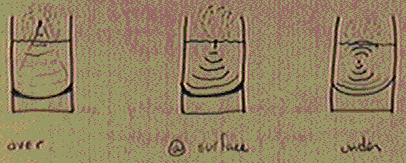
The crazy idea I had was to adapt a piece of hospital equipment called an ultrasonic nebulizer for use in automobiles as an "Ultrasonic Carburetor".
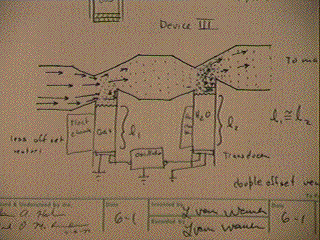
The energy crisis was swinging into high gear and MPG was becoming a national concern. I had observed that ultrasonic devices were capable of producing an extremely fine mist, a mist that helped people to clear their lungs, a mist that would also help fuel to burn more completely. This would increase MPG while simultaneously handling another pet peeve of mine, air pollution.
So here I was in the summer of 1977, building a working prototype of
an ultrasonic carburetor.
After a lot of trouble I managed to demonstrate it at the end of the summer.
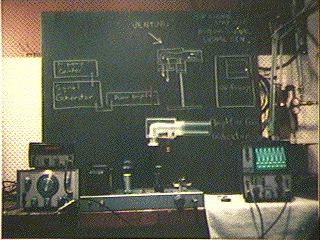
During development I started with water, and then graduated to alcohol as the working fuel, rather than gasoline. This was safer in our modestly equipped laboratory conditions and got the point across.
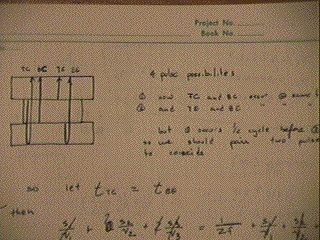
I did a fair amount of mathematical modeling while thinking about how I wanted it to go together.
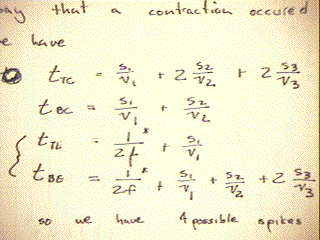
An interesting anomaly developed during the course of testing. Every time I ran the system with isopropyl alcohol, a Lucite column that held the fuel would craze and fracture, crack and break. This would be accompanied by an aldehyde-like odor.
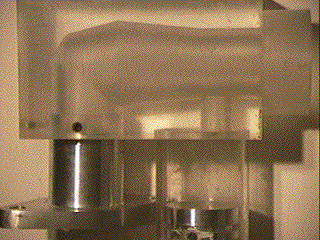
This annoying occurrence required the Lucite column to be replaced. I made a mental note of what had happened.
The summer was running out and I was back to my studies before I could pursue the matter further. I got married and moved to the University of Illinois where after 200 college hours of I finally got a BS and MS in aeronautical engineering. After that I went to the University of Utah to learn about computer graphics. In 1985, I graduated with a second masters degree, this time in computer science.
The Lucite crazing incident had slipped my mind until February of 1995 when I stumbled across an article by Seth Putterman of UCLA on an intriguing phenomenon called sonoluminescence - sound into light. First documented in WWII Germany, it was rediscovered by Putterman and his students. It turns out that small bubbles of air, when suspended in an ordinary flask, will emit a flash of light when exposed to an ultrasonic signal of just the right frequency.
This in and of itself would be enough to raise one's scientific curiosity but the calculations that Putterman and his students had done appeared to satisfy three important conditions:
1) The bubble undergoes a trillionfold change in volume implying confinement.
2) The gas in the bubble is superheated possibly to critical temperature.
3) This is repeatable for significant durations of time hinting at containment.
Even a hobby physicist like me saw that these are the long sought after conditions for nuclear fusion ... the clean and endless energy source promised since the fifties.
After I left the University of Utah, I worked as a system engineer at the Jet Propulsion Laboratory from 1985 to 1990, and was fortunate to find modest success. In 1987 a huge debacle erupted in Utah over purported "cold fusion" occurring at room temperature. Because of the high stakes, two of the scientists involved had hastily called a press conference. Enormous excitement and a media circus ensued. A lid of secrecy was clamped on the project. Many people got drawn into the potentialities. The former head of NASA at the time, James Fletcher, was said to have been making his way to Salt Lake City while scientists all over the world attempted to reproduce the experiment. Palladium futures soared. After a while the whole flap died as quickly as it had erupted, leaving only a few true believers in the scattered remains of its bureaucratic wake, a cold fusion information clearinghouse in Salt Lake.
Perhaps because of Utah furor, the language Putterman used in the Scientific American article was careful and subdued. But the ramifications were clear to anyone that had even a passing interest in physics.
What Putterman had left out of his article was even more significant than what he had published, i.e. the trio of containment + temperature + confinement. The silence was deafening. I called him at UCLA and mentioned that if one could get deuterium, lithium-6, or tritium inside the bubble one might get more than just a dim flash of light. He agreed.
I told him, "I would like to perform such experiments myself, but I am a little concerned about what my workshop might look like following a "successful" outcome. He agreed but added, "Who cares if your workshop is gone ... you'd be famous". I pointed out that, "there was only so much I was willing to do for a little fame". We discussed getting any of the three key materials inside a little bubble. We discussed what spectral lines were showing up during the flash. We discussed the effects of acids and bases on the phenomena effects which were nil. After our conversation, I kept thinking about variants of the idea. I faxed him a summary of our conversation including a description of my 1977 incident with the cracking Lucite. I still hadn't resolved this. There was also the nagging problem that sonoluminescence required argon to manifest itself. Why?
Variations
One Mr. Fusion variant I thought of was filling the flask with mercury instead
of water. Mercury looked interesting for several reasons. It's acoustic
properties are favorable than water. Mercury has the same speed of sound
as water, but it's density is almost fourteen times larger. This might yield
more singular bubbles with larger volume ratios. It is a good shielding
material. But with this comes its disadvantage... You can't see the flash
of light.
My sense was that this experiment should be done by the capable hands of a properly equipped lab with the appropriate charter. Lawrence Livermore (LLL) seemed like the right place. I called Willie Moss, a physicist at LLL and asked him if he thought this would fly. He said that he had recently done calculations that indicated that there might be some promise. He said they had not seen any neutrons - the true moniker of fusion - in their experiments at that date. He said he was getting ready to present some preliminary results to a conference/journal of acoustics letters, I don't remember exactly which. I faxed Willie the same summary with our conversation appended to the end, hoping to generate some cross fertilization and enthusiasm for continuing. Still no insight on the Lucite crazing problem.
As a final stop I called Kenneth Suslick, from my own alma mater, the University of Illinois. He proposed that the crazing was due to local heating and thermal effects in the Lucite. I mentioned that the effect only occurred when alcohol was the working fluid, not with water. This created some uncertainty about the thermal theory. He proposed that the aldehyde like odor was from the Lucite decomposing. I felt that it might be catalysis of the isopropanol into an aldehyde class solvent which then attacked the Lucite. After all, chemical catalysis via ultrasonics is a documented phenomenon.
What is so significant about Putterman's experiment is that it only works
for extremely small volumes of fuel, contained within a 50 micron ultrasonic
bubble. This provides a built-in safety mechanism. Each bubble
constitutes a fuel pellet that when fused can heat an appreciable volume
of working fluid to the boiling point. Hot working fluid means mechanical
propulsion. Mechanical propulsion means clean happy industry and transporation.
The input fuel is just heavy water, of which there is, "a limitless
supply." Could this be made into a roadworthy and
workable engine, into a nanotechnology meets nuclear energy, Mr. Fusion
coffee maker? Inquiring minds want to know...
© 1996 L. Van Warren · All Rights Reserved